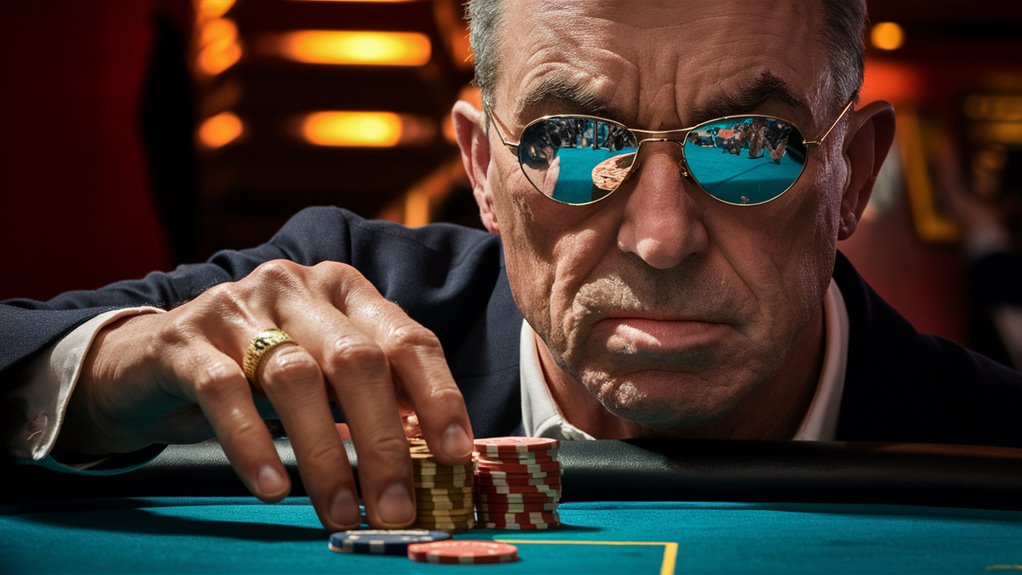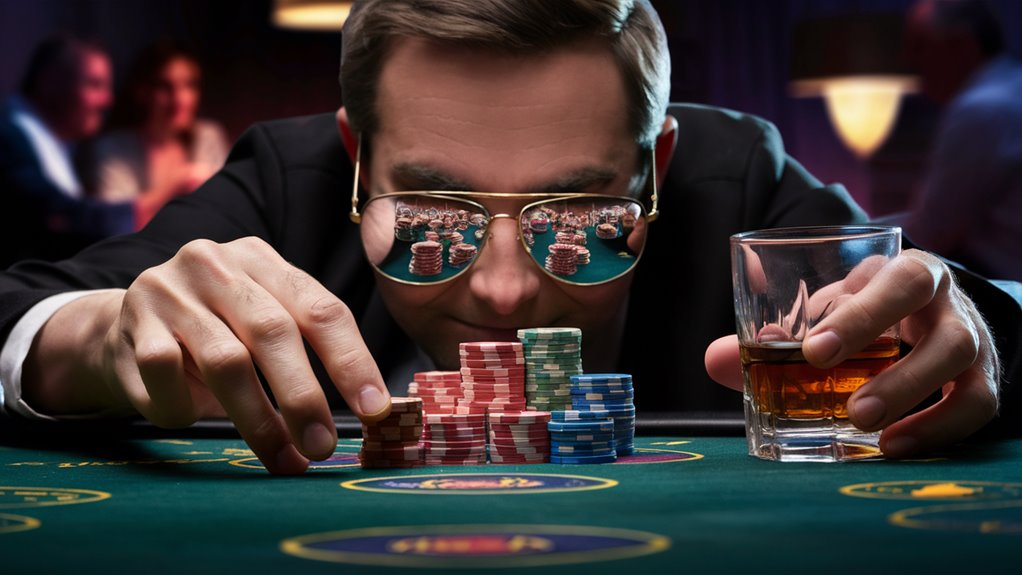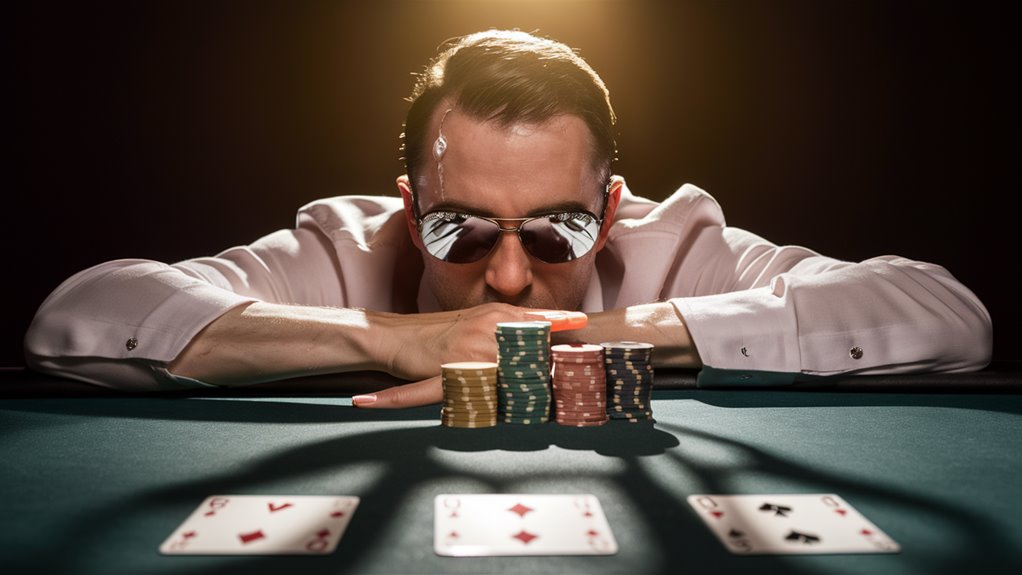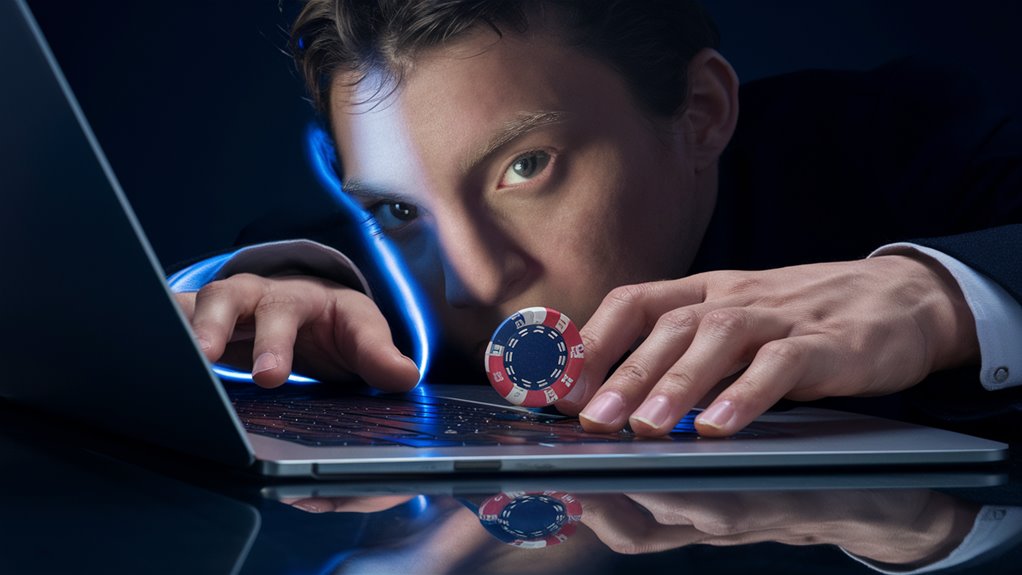Mastering Advanced Poker Bluffing: Psychology and Strategy Guide
The intricate art of poker bluffing extends far beyond aggressive betting patterns. Through extensive research and analysis, advanced poker psychology reveals that successful deception requires mastering multiple elements: table dynamics, opponent profiling, and precise timing.
Understanding the Psychology of Poker Deception
Strategic bluffing relies on creating compelling narratives that exploit fundamental human decision-making patterns. Effective bluffs incorporate physical tells, betting patterns, and table image to construct believable scenarios that force opponents into difficult decisions.
Key Components of Advanced Bluffing
- Position-based deception
- Timing manipulation
- Image exploitation
- Behavioral consistency
- Pressure point identification
Advanced Table Dynamics
Mastering poker table dynamics requires understanding the complex interplay between stack sizes, player tendencies, and situational awareness. Professional players consistently demonstrate that successful bluffing depends on recognizing and exploiting these interconnected elements.
FAQ: Advanced Poker Bluffing
Q: What makes a bluff effective?
A: Effective bluffs combine credible betting patterns, consistent table image, and precise timing while exploiting opponent tendencies.
Q: How often should players bluff?
A: Optimal bluffing frequency varies based on game dynamics, opponent profiles, and table position, typically ranging from 25-30% of hands.
Q: What are key tells to watch for?
A: Critical tells include betting speed variations, physical movements, chip handling patterns, and timing deviations.
Q: How can players improve their bluffing success rate?
A: Focus on developing consistent betting patterns, studying opponent tendencies, and maintaining awareness of table dynamics.
Q: What are common bluffing mistakes?
A: Common errors include over-bluffing, ignoring position importance, and failing to account for opponent profiles and stack sizes.
The Psychology Behind Modern Bluffs

The Psychology Behind Modern Poker Bluffs: A Comprehensive Guide
Understanding the Psychological Framework
Modern poker bluffing requires a sophisticated understanding of human psychology and decision-making patterns.
The contemporary aggressive playing style demands mastery over cognitive biases and emotional triggers.
Through systematic analysis and strategic implementation, successful bluffs create compelling narratives that exploit opponents' psychological vulnerabilities.
Player Profiling and Strategic Adaptation
Opponent tendency analysis forms the foundation of effective bluffing. Identifying key behavioral patterns – whether an opponent folds frequently or calls excessively – enables targeted strategic adjustments.
Timing optimization becomes critical when opponents face emotional pressure or mounting stress, creating prime opportunities for successful bluffs.
Advanced Bluffing Techniques
Consistent betting patterns and precise sizing remain crucial elements in constructing believable narratives.
Strategic bet sizing must align with genuine strong-hand scenarios, while maintaining awareness of physical tells enhances bluff credibility.
The combination of authentic tension and controlled composure creates optimal deception potential.
Psychological Principles in Action
Loss aversion psychology plays a central role in modern bluffing strategy.
Even experienced players exhibit vulnerability when facing potential losses in pots they perceive as rightfully theirs.
Understanding these fundamental psychological motivations enables the construction of sophisticated bluffs that target deep-seated competitive insecurities.
#
Frequently Asked Questions
Q: What makes modern poker bluffs different from traditional ones?
A: Modern bluffs incorporate advanced psychological principles and detailed opponent analysis, moving beyond simple deception to structured strategic approaches.
Q: How important is timing in successful bluffing?
A: Timing proves crucial, particularly when opponents experience emotional pressure or stress, creating optimal windows for bluff execution.
Q: What role does bet sizing play in believable bluffs?
A: Precise bet sizing must maintain consistency with strong-hand patterns to create credible narratives and avoid detection.
Q: How does loss aversion impact bluffing success?
A: Loss aversion significantly influences opponent decision-making, making players more susceptible to bluffs when facing potential losses in pots they feel entitled to win.
Q: Can physical tells enhance bluffing effectiveness?
A: Strategic management of physical tells, combining genuine tension with practiced composure, strengthens bluff credibility and success rate.
Building Credible Betting Stories

Building Credible Betting Stories: A Strategic Poker Guide
Mastering Betting Narratives in Poker
The foundation of successful poker betting stories relies on creating coherent, psychologically sound narratives that convince opponents.
Each betting action must contribute to a logical progression that aligns perfectly with the hands being represented throughout play.
Creating Consistent Betting Patterns
Strategic betting patterns require careful consideration of multiple factors:
- Street-by-street consistency in bet sizing
- Position-based adjustments
- Stack size considerations
- Previous action analysis
Advanced Storytelling Elements
Timing tells and physical mannerisms play crucial roles in maintaining believable betting narratives. Successful implementation requires:
- Consistent bet timing
- Proportional bet sizing
- Controlled table presence
- Strategic hand representation
Frequently Asked Questions
Q1: How do you maintain betting consistency across streets?
Ensure bet sizes correlate with the hand strength being represented and maintain logical progression from flop to river.
Q2: What role does position play in betting stories?
Position influences betting patterns and helps determine optimal sizing for maximum credibility.
Q3: How important are physical tells in betting narratives?
Physical consistency reinforces betting stories and prevents opponents from detecting inconsistencies.
Q4: What makes a betting story believable?
Logical progression, consistent sizing, and alignment with previous actions create compelling narratives.
Q5: How do stack sizes affect betting stories?
Stack depths influence bet sizing options and help determine credible betting patterns throughout the hand.
Key Strategic Considerations
- Maintain narrative consistency
- Align actions with represented hands
- Consider opponent perception
- Adjust sizing appropriately
- Monitor physical tells
Reading Micro-Expressions Like Pros

Mastering Micro-Expression Reading: A Professional Guide
Understanding Facial Zones for Behavioral Analysis
The science of micro-expression reading provides critical insights into human behavior through the analysis of involuntary facial movements.
Professional observers focus on three primary facial zones that consistently reveal underlying emotions within fractions of a second.
Mouth Region Analysis
Oral micro-expressions serve as powerful indicators of emotional states. Key signals include:
- Subtle corner twitches indicating internal conflict
- Brief lip compressions revealing stress patterns
- Micro-smirks suggesting confidence or deception
Eye Movement Patterns
The eyes function as precise emotional indicators through:
- Pupil dilation occurring during moments of excitement
- Micro-squints lasting approximately 1/25th second
- Rapid eye movement patterns signaling internal processing
Forehead and Brow Indicators
Upper facial movements provide crucial behavioral data:
- Quick eyebrow raises revealing surprise
- Momentary muscle furrowing showing concentration
- Micro-tension patterns indicating decision-making
Developing Advanced Observation Skills
Systematic skill development requires focused practice on individual facial zones.
Begin with single-zone observation sessions before advancing to integrated analysis.
Establish baseline behavioral patterns during low-stress periods to accurately identify significant deviations.
Frequently Asked Questions
Q: How long does it take to master micro-expression reading?
A: Professional proficiency typically requires 3-6 months of dedicated practice.
Q: Which facial zone provides the most reliable information?
A: The eye region consistently delivers the most accurate emotional data.
Q: Can micro-expressions be controlled?
A: True micro-expressions occur involuntarily and can't be consciously suppressed.
Q: What's the average duration of a micro-expression?
A: Authentic micro-expressions last between 1/25th to 1/15th of a second.
Q: Are micro-expression patterns universal across cultures?
A: Core emotional micro-expressions remain consistent across cultural boundaries.
Manipulating Your Table Image

Mastering Table Image Manipulation in Poker
Strategic Image Control for Advanced Players
Table image manipulation represents one of poker's most sophisticated strategic elements, allowing players to systematically influence opponents' decision-making processes through carefully crafted personas and behavioral patterns.
This comprehensive guide examines proven techniques for developing and adapting your table presence.
Establishing Your Baseline Image
Begin by constructing a foundational table image – typically a tight-aggressive or conservative profile that suggests disciplined hand selection.
This initial persona should be maintained for approximately 60-90 minutes, allowing opponents to form concrete assumptions about your playing style.
Advanced Image Shifting Techniques
Deploy strategic image transitions by:
- Implementing unexpected aggressive moves against established patterns
- Utilizing position-based image manipulation
- Executing calculated pattern breaks during key moments
- Incorporating deliberate physical tells and counter-tells
Psychological Warfare Through Image Control
Master the art of multi-level thinking by:
- Creating false patterns in betting sequences
- Displaying calculated emotional responses
- Varying verbal and non-verbal communication
- Timing image shifts with table dynamics
Frequently Asked Questions
Q: How long should I maintain a specific table image?
A: Maintain initial images for 60-90 minutes minimum before implementing strategic shifts.
Q: What're effective triggers for image transitions?
A: Key moments include post-big pots, after significant player eliminations, and following table dynamic shifts.
Q: How can I prevent opponents from detecting deliberate image manipulation?
A: Implement gradual changes, avoid obvious patterns, and tie transitions to natural game flow points.
Q: Which table positions best support image manipulation?
A: Late positions offer optimal control for image shifts, while early positions require more subtle adjustments.
Q: What're the most reliable physical tells to incorporate?
A: Timing patterns, betting motions, and verbal frequencies provide consistent manipulation opportunities.
Multi-Street Bluffing Strategies

Mastering Multi-Street Bluffing: Advanced Poker Strategy Guide
Understanding Board Textures and Range Analysis
Multi-street bluffing requires sophisticated analysis of board textures and precise execution across multiple betting rounds.
Identifying boards where opponents hold capped ranges creates optimal bluffing opportunities, as these scenarios limit their premium hand possibilities.
Strategic Opponent Selection and Bet Sizing
When implementing multi-street bluffs, target opponents demonstrating these key characteristics:
- Willingness to fold better hands
- Conservative calling tendencies
- Predictable betting patterns
Bet sizing consistency plays a crucial role in maintaining hand representation credibility. Size bets according to the premium hands being represented to maximize fold equity.
Advanced Bluffing Execution
Planning Future Streets
Successful multi-street bluffing demands comprehensive planning for subsequent betting rounds.
Turn card selection becomes critical when continuing aggression, requiring careful consideration of cards that support the narrative being told.
Blocker Effects
Blocker-based bluffing enhances success rates by holding cards that prevent opponents from having strong calling hands. This strategic element proves particularly valuable when executing triple-barrel bluffs.
Frequently Asked Questions
- What board textures are best for multi-street bluffs?
- How should bet sizing vary across different streets?
- When should players abort a multi-street bluffing attempt?
- What role do blockers play in multi-street bluffing?
- How does opponent selection impact bluffing success?
Through disciplined application of these advanced concepts, multi-street bluffing becomes a powerful weapon in the arsenal of strategic poker play.
Remember that successful execution requires careful spot selection and unwavering commitment to the planned betting line.
Digital Deception in Online Poker

Digital Deception Strategies in Online Poker
Understanding Online Tells and Timing Manipulation
In the digital poker landscape, psychological warfare takes on new dimensions distinct from live gameplay. Without physical tells, players must master digital deception techniques through timing patterns and bet sizing.
Strategic timing manipulation becomes a powerful tool, including deliberate variations in response speed – from instant calls projecting confidence to maximum time bank usage suggesting uncertainty.
Advanced Digital Deception Techniques
Auto-play functionality presents sophisticated opportunities for strategic manipulation. Alternating between manual and automated actions creates deceptive betting patterns that astute opponents may misinterpret.
Establishing consistent bet sizing creates perceived comfort zones, which can be strategically broken during crucial hands for maximum impact.
Chat Interface and Table Image Management
The chat functionality serves as a vital component in crafting table image. Professional players utilize strategic communication to project a recreational playing style while executing calculated strategies.
Online table presence is predominantly established through consistent betting patterns and timing tells rather than physical demeanor.
#
Frequently Asked Questions
Q: What're the most effective digital tells in online poker?
A: Key digital tells include betting patterns, timing consistencies, and chat behavior patterns.
Q: How can timing be used effectively in online poker deception?
A: Strategic variation of response times between snap decisions and time bank usage creates uncertainty in opponents' reads.
Q: What role does chat play in online poker strategy?
A: Chat helps establish table image and can be used to project a specific playing style that masks true strategic intentions.
Q: How important are betting patterns in online deception?
A: Betting patterns are crucial as they create expectations that can be leveraged for strategic advantage during key hands.
Q: What're the key differences between live and online poker tells?
A: Online tells focus on timing, betting patterns, and chat behavior, while physical tells are absent in the digital environment.
Timing Your Mind Game Attacks

Strategic Timing in Psychological Gameplay
Understanding Optimal Psychological Moments
Psychological gameplay effectiveness relies heavily on precise timing and execution.
The most impactful moments for implementing strategic psychology occur when opponents display clear signs of emotional vulnerability. These opportunities typically present themselves after significant losses, during low chip counts, or in moments of visible tilt.
Identifying Key Behavioral Triggers
Strategic observation reveals crucial behavioral patterns that indicate optimal timing:
- Frequent chip stack monitoring
- Audible signs of frustration
- Physical manifestations of stress
- Irregular betting patterns
- Heightened emotional responses
Maximizing Psychological Impact
Tactical pressure application proves most effective during moments of demonstrated weakness. Key situations include post-questionable decisions or missed opportunities.
Strategic timing encompasses both action execution and careful observation of opponent decision-making processes.
Frequently Asked Questions
Q: What're the primary indicators of opponent vulnerability?
A: Key indicators include frequent chip counting, visible frustration, erratic betting patterns, and signs of emotional distress.
Q: When should psychological tactics be avoided?
A: Refrain from psychological tactics when opponents display emotional stability or demonstrate optimal performance levels.
Q: How can timing enhance psychological strategy?
A: Strategic timing aligns tactical pressure with moments of opponent vulnerability, maximizing effectiveness.
Q: What role does observation play in psychological gameplay?
A: Careful observation enables precise identification of opportune moments for tactical implementation.
Q: How important is patience in psychological strategy?
A: Patience is crucial for identifying optimal timing and maximizing psychological impact during periods of opponent vulnerability.
Advanced Timing Techniques
Professional implementation requires refined observation skills and precise execution timing.
Focus on identifying genuine vulnerability indicators rather than superficial tells.
Maintain consistent observation while avoiding premature tactical deployment.
Common Questions
How Long Should I Wait Before Attempting Advanced Bluffing Techniques as a Beginner?
When to Start Using Advanced Poker Bluffing Techniques
For optimal poker skill development, I recommend waiting a minimum of 6-8 months of consistent play before incorporating advanced bluffing techniques into your strategy. During this crucial learning period, focus on mastering these fundamental elements:
- Basic poker mathematics
- Position play fundamentals
- Hand reading skills
- Player tendency analysis
- Bankroll management
Essential Prerequisites Before Advanced Bluffing
Master the basics by playing at least 200-300 hours of live poker or 50,000+ hands online. This experience helps develop:
- Solid understanding of pot odds and implied odds
- Recognition of betting patterns
- Comfort level with basic continuation betting
- Ability to read board textures effectively
- Strong foundational position play
Progression Timeline for Bluffing Skills
Months 1-3
- Focus on value betting
- Learn basic position play
- Practice pot odds calculations
Months 4-6
- Introduce simple bluffs
- Develop hand reading abilities
- Study opponent tendencies
Months 6+
- Begin implementing advanced bluffing techniques
- Execute multi-street bluffs
- Apply sophisticated betting patterns
## Frequently Asked Questions
Q: Can I start bluffing earlier if I'm a quick learner?
A: While possible, rushing into advanced bluffing typically leads to costly mistakes. Stick to the recommended timeline.
Q: What's the most important skill to master before advanced bluffing?
A: Hand reading ability is crucial – understanding likely opponent holdings based on their actions.
Q: How do I know I'm ready for advanced bluffs?
A: When you can consistently profit from basic strategies and accurately predict opponent actions.
Q: Should I practice bluffing in low-stakes games first?
A: Yes, always test new techniques at stakes where mistakes won't significantly impact your bankroll.
Q: What percentage of hands should involve bluffs as a beginner?
A: Keep bluffing frequency low initially – approximately 5-10% of hands maximum.
Can Meditation and Mindfulness Practices Improve Bluffing Abilities in Poker?
The Impact of Meditation and Mindfulness on Poker Bluffing Success
Understanding the Mind-Poker Connection
Meditation and mindfulness practices serve as powerful tools for enhancing poker performance, particularly when executing successful bluffs. Through regular practice, players develop heightened awareness of their emotional states and improved cognitive control, essential elements for maintaining composure during high-stakes situations.
Key Benefits for Poker Players
Enhanced Emotional Regulation
Mindfulness techniques enable players to maintain calm under pressure, preventing emotional tells that could reveal bluffing intentions. Regular meditation practice strengthens the ability to dissociate from stress responses, creating a more convincing poker face.
Improved Focus and Concentration
Meditation training sharpens mental acuity, allowing players to:
- Track betting patterns more effectively
- Notice subtle opponent behaviors
- Maintain strategic awareness throughout long sessions
- Process multiple information streams simultaneously
Advanced Opponent Reading
Mindful observation develops superior capabilities in:
- Detecting micro-expressions
- Interpreting betting timing tells
- Recognizing behavioral patterns
- Analyzing table dynamics
Q&A: Meditation and Poker Performance
Q: How long should poker players meditate to see results?
A: Regular 10-20 minute daily sessions typically show benefits within 2-4 weeks of consistent practice.
Q: Can meditation help reduce tilt in poker?
A: Yes, meditation strengthens emotional resilience and helps players maintain strategic thinking during challenging situations.
Q: Does mindfulness improve decision-making in poker?
A: Regular mindfulness practice enhances clarity of thought and reduces impulsive actions, leading to more calculated decisions.
Q: How does meditation affect bluffing frequency?
A: Meditation helps players better identify optimal bluffing opportunities rather than increasing bluffing frequency.
Q: Can mindfulness practice improve multi-table performance?
A: Yes, enhanced focus and awareness from mindfulness training support better multi-table management and decision-making.
What Percentage of My Bankroll Should I Risk on Sophisticated Bluffs?
Optimal Bankroll Management for Poker Bluffs
For sophisticated poker bluffs, I recommend limiting risk to 1-2% of your total bankroll per play. This conservative approach provides optimal protection while maintaining aggressive potential in strategic situations.
Key Bankroll Considerations for Bluffing
Sophisticated bluffing requires careful bankroll management to:
- Protect against downswings
- Maintain long-term profitability
- Enable multiple bluff attempts when conditions are favorable
- Preserve capital for value betting opportunities
Advanced Bluffing Strategy
When executing complex bluffs, consider:
- Board texture and opponent tendencies
- Position and stack depth
- Previous betting patterns
- Available fold equity
Recommended Bankroll Allocation
- Micro Stakes: 1% maximum per bluff
- Low Stakes: 1-1.5% per sophisticated bluff
- Mid Stakes: 1.5-2% for well-timed bluffs
- High Stakes: Never exceed 2% regardless of read strength
FAQ Section
Q: How often should I attempt sophisticated bluffs?
A: Limit sophisticated bluffs to 15-20% of total hands played, focusing on spots with clear fold equity.
Q: What's the minimum bankroll needed for complex bluffing?
A: Maintain at least 50 buy-ins for the stake level before attempting sophisticated bluffs.
Q: Should bluff sizing vary by stake level?
A: Keep bluff sizes consistent with value bets at respective stake levels while maintaining bankroll percentage limits.
Q: How do I adjust bluffing frequency for tournament play?
A: Reduce bluff sizes to 0.5-1% of tournament stack during early stages, increasing only in late-game situations.
Q: What's the recovery strategy after a failed bluff?
A: Return to fundamental value betting until recovering at least twice the lost amount before attempting another sophisticated bluff.
Are Bluffing Patterns Different Between Live Tournaments and Cash Games?
Bluffing Patterns: Tournament vs Cash Game Poker
Tournament and cash game bluffing require distinctly different strategic approaches based on their unique formats and risk structures. In tournament poker, bluffing decisions must be carefully calibrated due to the finite nature of chips and elimination risk. The inability to rebuy creates a scenario where preservation of tournament life becomes paramount, necessitating more selective bluffing spots.
Tournament Bluffing Dynamics
In tournament settings, optimal bluffing frequency decreases as the tournament progresses, particularly near bubble situations and pay jumps. Stack preservation takes precedence over maximizing immediate profit potential, leading to more conservative bluffing patterns. Players must consider ICM implications when selecting bluffing opportunities, as the real-money value of chips changes throughout the tournament structure.
Cash Game Bluffing Strategy
Cash game environments offer greater flexibility for creative bluffing lines due to the ability to reload. This format allows for:
- More aggressive bluffing frequencies
- Higher-variance plays
- Extended multi-street bluffing sequences
- Creative line manipulation
The constant stack-to-blind ratio in cash games enables players to maintain consistent bluffing patterns without worry of tournament elimination.
## Frequently Asked Questions
Q: When should I bluff in tournaments vs cash games?
A: Tournament bluffs should focus on high-probability spots with clear fold equity, while cash games permit more speculative bluffs due to reload availability.
Q: How does stack size affect bluffing decisions?
A: Shorter stacks in tournaments require more selective bluffing, while deep-stacked cash games allow for more complex multi-street bluffs.
Q: Are bluffs more profitable in cash games or tournaments?
A: Cash game bluffs typically offer higher immediate EV, while tournament bluffs must factor in ICM considerations.
Q: Should bluffing frequency change based on tournament stage?
A: Yes, bluffing frequency generally decreases during crucial tournament stages like bubble play and final table approaches.
Q: How does the ability to rebuy affect bluffing strategy?
A: The rebuy option in cash games enables more aggressive bluffing patterns, while tournament play requires more conservative bluff selection.
How Do Cultural Differences Affect Bluffing Effectiveness Against International Players?
Cultural Differences in Poker Bluffing: An International Perspective
When analyzing bluffing effectiveness across different cultures, it's essential to understand how cultural norms and playing styles vary significantly among international players. Based on extensive tournament experience and data analysis, distinct patterns emerge in how players from different regions approach bluffing and respond to aggressive plays.
Regional Bluffing Patterns
Asian poker players typically demonstrate a more conservative approach, employing bluffs selectively and often showing greater patience in pot development. This measured style reflects cultural values emphasizing calculated risk and long-term thinking.
European players frequently exhibit more aggressive tendencies, particularly in tournaments. Their bluffing frequency tends to be higher, with a notable preference for semi-bluffs and pressure plays, especially in position.
Adjusting Strategy for Maximum Effect
To optimize bluffing success against international opponents:
- Against Asian players: Implement well-timed, larger bluffs as they're less likely to call without premium holdings
- Facing European opponents: Use more selective bluffing as they're prone to making hero calls
- In mixed-culture tables: Adapt quickly by observing individual playing patterns rather than relying solely on cultural tendencies
Common Questions About Cross-Cultural Poker
Q: How do cultural differences affect bluff detection?
A: Different cultures exhibit varying physical tells and betting patterns, requiring adaptable observation skills.
FAQ:
1. Does playing style vary by region?
Yes, significantly – from tight-aggressive in Asia to loose-aggressive in parts of Europe.
2. How important is understanding cultural context?
Critical – it influences decision-making processes and risk tolerance levels.
3. Can cultural patterns be reliable indicators?
They provide useful baseline information but should not override individual player analysis.
4. Do online players show similar cultural patterns?
Less pronounced but still observable through betting patterns and timing tells.
5. How do cultural differences impact tournament play?
They influence stack preservation, aggression levels, and late-game strategies significantly.
